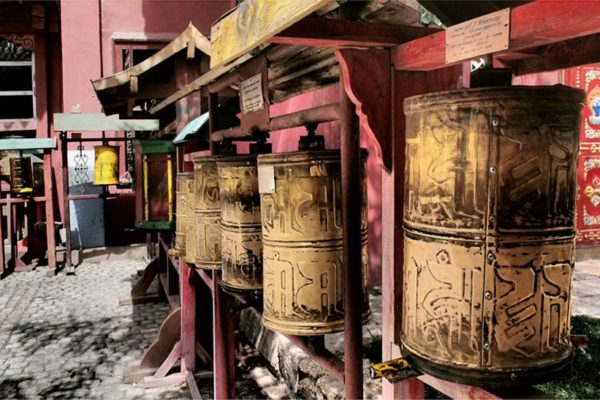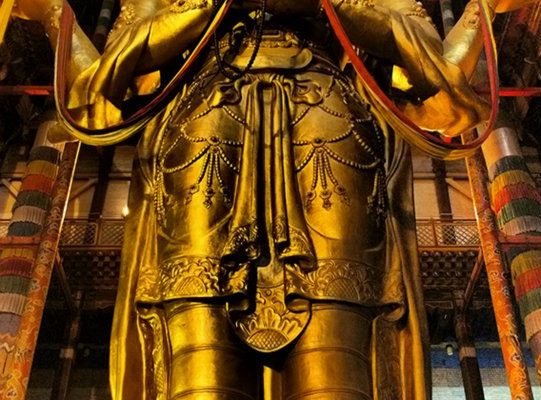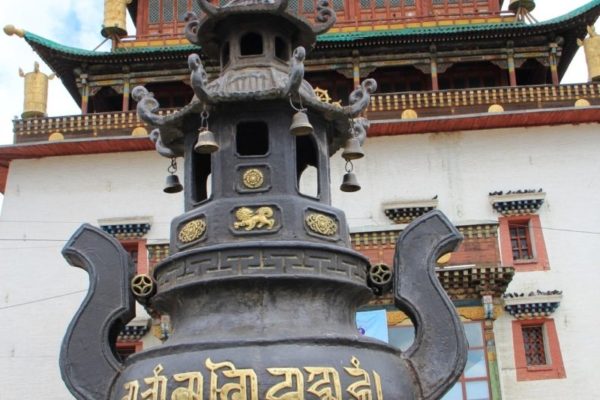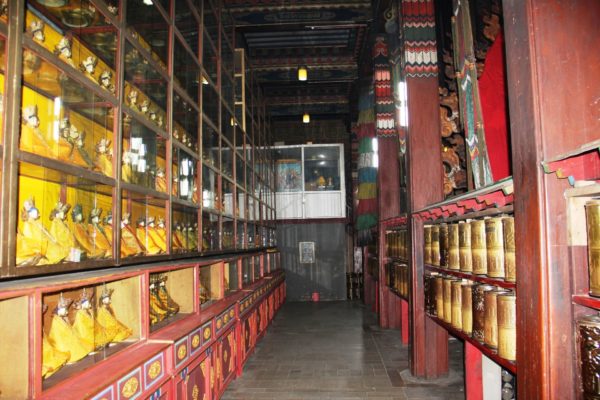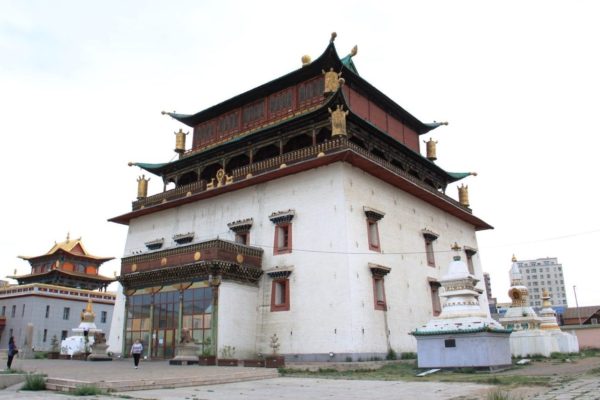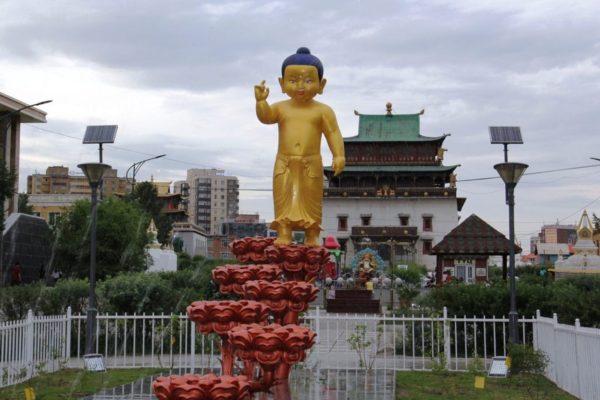The Gandanteghenlin Monastery was founded in 1809 with the construction of the Yellow Temple on Dalkh Terrace. The monastery, also known as the “Monastery of Tugs Bayasgalant,” features the Choir Temple and Lamrim Temple. In 1838, Ikh hot Mandli Temple, Dashchoynkhor, and Yagdachoilin were built for the 5th Bogd and expanded. However, in 1938, the monastery was closed, and some temples were destroyed. In 1944, under the strict control of the party, a meeting called “Murgul Dugan or Praying Temple” was held, and its religious activities were restored. In 1994, six existing churches were taken under state protection. The buildings were constructed with Mongolian, Mongolian-Chinese, and Sino-Tibetan designs using wood, stone, brick, and various blue-glazed pottery, decorated with gilded ganjir, choinkhorol, bodhi antelope, and bells. The first stupa was built in the yard of Gandan Monastery in 1958 on the 2500th anniversary of Buddha’s birth.
Gandan Temple
The Gandan Temple is the main temple of the Gandantegchenlin Monastery. It was built by talented craftsmen by the decision of the 5th Bogd Saint. Inside the Gandan temple, there is a bronze statue of an old nobleman made by Saint Zanabazar, 108 volumes of Ganjuur written in gold on black paper by Mongolian monks in the 19th century, a portrait of Buddha made by the monks of Gandan monastery on the occasion of the 2500th anniversary of the Buddha’s birth in 1956, former President of India Jawaharlal Nehru, and precious religious and cultural works such as a 2,000-year-old cast statue of Buddha, a silver stupa brought from Sri Lanka, and an image of Bogd Zonkhov, made of 15 kilograms of pure silver, which were given to him during his visit to Mongolia.
Among the idols known as the “Seven Precious” of Zanabazar, the first Bogd installed the gods Ochirdara, Ayush of Ganjuur, Manla of the Lord idol, Mother Dara, Namsrai, and Maidar. The library has more than 50,000 books and scriptures collected during the flourishing of Zoroastrianism. For example, in addition to Derge Bar’s Ganjuur, Danjuur, and Khuree Bar’s Ganjuur, the writings of Bogd Zonkhov, Dalai Lama, Banchin Bogd, philosopher Agwaanbaldan, Agwaantuvden, Damtsagdorj, and Zava Damdin are preserved. Along with books made of gold, silver, and nine gems, there are rare relics of Mongolian, Tod, Soyombo, Lanz, Sanskrit, and Tibetan characters. This very rich book is not only a valuable heritage of the traditional religious history and literary culture of Mongolians but also a research study.
The grounds of Gandan Monastery include Janraisig Temple, Dashchoinpel Temple, Gungaachoilin Temple, Denchingalav or Duinkhor Temple, Jud Temple, Bogd Zonkhov image, religious institute established in 1970, and pagodas.
Dashchoinpel Temple is southeast of the four temples located behind the Gandan Temple. It mainly studies the five-volume works of the famous Tibetan philosopher Gunchen Jamyanshaduw. The Temple was established in 1736 by Bogd II and teacher Yongzin Donkhor Tsorj in Dolonnuur, Inner Mongolia. Then, in 1756, it came and settled in Ar Khalkh Khuren. It was closed in 1937, but it was reopened in 1991 and revived according to tradition with the arrival of teachers from Gomon Monastery in India. Since 1991, 36 monks have been promoted to geshes and more than 220 monks have been promoted to geshes.
Gungaachoilin Temple is located in the southwest of the four temples and was built in 1809 for the 4th Bogd. It is one of the main temples for the study of Buddhist philosophy, and the 8th Buddha held his rites in this temple.
Dechingalav or Duynkhor Temple is located to the west of the four mosques. In 1800, it was initiated by Duynkhor in the 4th Bogd West, and the following year, the temple was established. It was a school that mainly studied the book “The Wheel of Time.” It was closed in 1937 and restored in 1944, and from 1961 Duynkhor meeting was held once a year. In 1990, the 14th Dalai Lama recited “The King of Duinkhor.” In 1993, the Duynkhor meeting of the church was officially started.
Idgaachoinzinlin or Jud Temple is located to the east of the four mosques and is the temple built by the 8th Bogd in 1910 in the place where the foundation of the 5th Bogd was laid. Starting from 1912, the book “Tumen Gelengi Hayalan” was published three times a year. The temple mainly studies the five volumes of Buddhist philosophy of the Tibetan philosopher Serjevzunba Choijizhaltsang. In 1991, the traditional training was resumed.
Megjidjanraisag Statue
Janraisig Temple is a thirty-meter-high building that was constructed in 1911. It used to be the tallest building in the capital city and was home to a twenty-six-meter-tall Megjidjanraisig deity. The first statue was built for Saint Bogd 5, but it was taken down in 1938 and shipped to the Soviets. The temple remained empty until 1990. When the main four pillars of the temple were erected, the Mongols brought eighty cubits of young pine trees from Noyon Mountain, where the remains of the Hun kings are kept. They carried agar-filled water with mahogany pots, and water used in the building was carried from hand to hand, not by land.
Reconstruction
The current statue, Megjidjanraisig, was created over six years from 1990 with public donations. It was opened to the public on October 27, 1996. The body of the great statue was crafted from nineteen tons of copper, and inside it were treasured stones brought from all provinces and historical monuments of Mongolia, samples of hot and cold springs, samples of rare medicinal herbs and juniper, grain samples, sacred Buddhist scriptures, Mongolian secret bureaus, famous historical scriptures such as Geser and Jangar, horse fiddles with strings made from the tails of horses, etc. Only books weigh seventeen tons. The body of the Great Buddha was covered with seventy-five thousand nine hundred twenty-six pieces of gold leaf measuring 5 x 5 cm, and one thousand three hundred fifty-six grams of gold was used to gild the four hands in the traditional way of making gods in the East. There are three hundred four pieces of twenty-one types of gems collected from twenty-two provinces, and two thousand two hundred eighty-six pieces of precious stones are embedded in the crown called “Sangiin Us” of the great statue. The bosom and apron of the great statue are made of about one hundred meters of silk. Guridava Renbuche selected the silk and cloth from Varanasi, India, and woven a fifty-meter-long, five-color Hadag across the hands of the great deity. The previous altar was made by the sculptor L. Chuwaami, five meters long, two meters wide, and 1.55 meters high, and it was the largest table ever made. Seven state treasures and eight religious sacrifices are placed on the table, made of copper and silver and decorated with gold.
Meaning of the name Janraisag
The meaning of the word “Janraisig” is “seeing how the six species of animals are suffering.” The heart mantra of Lord Janraisig is a six-letter mantra that is well-known to everyone. People learn this mantra without being taught by someone, they don’t forget it, and they don’t ask what is the meaning of “um mani.” A knowledgeable person does not brag to each other that they know a lot of books. “Um ma ni bad mi hum” is said three times at a time. Megjidjanraisig has a spring dome in the left hand of the idol, and the eternal water inside has the power to sanctify things and symbolizes eternal life if drunk. In the deity’s left hand, there is a magical mirror, and it is symbolic of looking at the bad deeds done by people and correcting their sins. On the chest of the great god, two hands are placed in a meditative state, and the eternal water dripped from the palm of the left hand is squeezed by the index finger of the right hand, meaning that it is given to good people.
Remains of the Bogds
In the yard of Gandantegchenlin Monastery, some temples kept the remains of Bogds 5, 7, and 8. However according to the resolution of the Central Committee of the People’s Republic of China on December 27, 1937, Gandan Monastery ceased to be a place of worship, the building was destroyed, and Megjidjanraisig Temple was given to the Russian military camp. The 8th Bogd mortuary temple was destroyed. According to the tradition of cremation of nobles, avatars, and dignitaries, the remains of the 5th, 7th, and 8th Bogds were cremated, and a stupa was built from the ashes and placed in the temple.
Wishing Tree
There is a column called the “Wishing Tree” in Gandantekhilen Monastery. It is one of the four main pillars of the original Gungaachoilin temple. Just like the legend of worshiping a single stone in the field as a god, it is believed that any wish will come true when wishing on the Wishing Tree. This is because when the monastery was set on fire during the Great Repression, the only pillar of the Gandan Monastery remained intact. When erecting the main pillar of a temple, Mongolians have a tradition of surveying the ground, selecting young, bright, and clean trees, and then erecting them. It is believed that the ten spells that were buried when it was built more than 200 years ago are still preserved.

